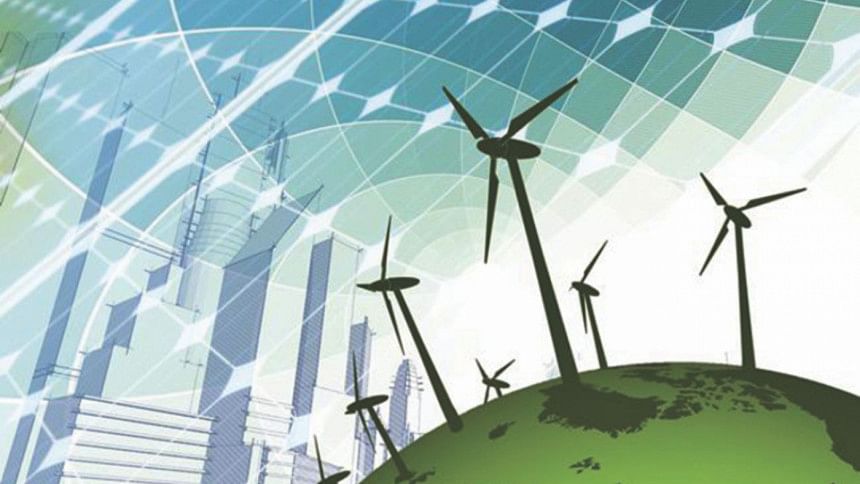The bright future of renewable energy

The advantages of renewable energy like solar, wind and tides are well known, i.e. they do not produce any pollutants, greenhouse gasses and are eco-friendly. Perhaps the greatest advantage is that they do not require any fuel and are free of international price whims. All that is required to set them up are places with abundant sunshine, wind and tidal power and the sources of these energies are practically unlimited. The great disadvantage, however, is that we do not have any control over energy production. In spite of this drawback, the International Energy Agency predicts that by the middle of this century the sun will be the largest source of energy superseding fossil fuel, wind, hydro and nuclear. If renewable energy is to play an important role in our future energy mix then energy storage and more efficient systems have to be devised.
Are the days of flat solar panels that we are so used to seeing, over then? Not yet, say the scientists. Even though smart technologies and new methods of harvesting energy are being added regularly, the solar panel will be with us for some time. One smart device that has attracted attention is the thin film technology. The solar thin films printed in bulk reduce both manufacturing and installation costs. As technology improves, the solar harvesting material could be integrated into rooftop material.
Another great idea is the solar window. These are ordinary looking windows that have been coated with electricity generating material but still remain transparent. The coating material on these windows is the world's smallest working solar cells occupying a space of less than a millimeter. It is believed that nanotechnology will also play an important role in future energy harvesting. Nanowires are light solar energy absorbing material. These nanowires are four to five times more efficient at converting solar energy into electricity than silicon based solar panels.
The problem with installing solar panel is the relatively high cost of an inverter – a device that converts direct current (DC) solar thermal electricity into alternate current (AC) that we use in our homes. However, with the advent of micro inverter technology, it is possible to have just one panel to start the solar power generating system and at a much lesser cost. The infrared spectrum solar panel is another smart device that harvests not only visible light spectrum into energy but also converts infrared spectrum into electricity.
A team of scientists at the University of California, San Diego's School of Engineering on nanoparticle paints have developed a nanoparticle paint that makes concentrated solar power (CSP) plants work more efficiently. CSP employs thousands of mirrors to generate electricity, can convert 90 percent of the absorbed heat into electricity and work even in the dark, unlike any other available technology.
There is no denying that from big corporations to individuals everyone's interested in clean solar technology. But the problem has always been about how to store it. Although progress has been made in the form of Tesla Powerwall and the MIT research spin off (Liquid Metal Batteries) we still have to rely on grid supply at night. Solar cells must harvest energy when the sun shines, so unless we can station solar panels high in space and beam power back to earth we have to keep our house hooked to the grid.
Waves and tides are some of the most predictable big energy sources available. However, it has received less media attention than solar and consequently less funding. High altitude winds, way above the ground, have historically been beyond our reach. With the progress of science and technology we could be on the verge of converting that wind energy into electricity. Investments are available now to build airborne turbines that could float in space and beam down the energy. But as with parking solar panels in space, the engineering challenges remain formidable. Other advances in the field use the jet engine concept of wind energy and the magnetic levitation in wind turbines to reduce friction thereby increasing efficiency. There are a couple of interesting ideas to harness the tidal energy – buoys or other above and below the sea surface design and oscillating hydrofoil moored to the ocean floor; as the water passes, it oscillates the buoys and hydrofoil generating electricity.
With about 40 percent of Bangladesh's population having no access to grid electricity, the government's Solar Home System (SHM) has proved to be a great success. The programme has already reached 3 million homes as of late 2014 and the World Bank has called it "the fastest growing solar home system in the world". With more than 50,000 systems being added every month the government's vision of providing universal electricity to everyone by 2021 appears well on course. In the meantime however, we should strengthen our R&D in universities and research organisations and manufacture our own solar panel.
The author is Professor of Physics, Jahangirnagar University, Fellow of the Royal Astronomical Society (UK) and Fellow of the Bangladesh Physical Society.

 For all latest news, follow The Daily Star's Google News channel.
For all latest news, follow The Daily Star's Google News channel. 



Comments